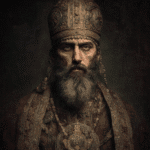
The emergence of Serbia as a defined political and cultural entity in the early medieval period was shaped by both internal developments and the influence of powerful neighbors: the Byzantine Empire to the southeast and the Frankish realm in the west. By the 10th century, the Serbian principalities had asserted their identity, moved toward unification of the fragmented Balkan territories, and embraced Orthodox Christianity as the defining core of their state and society.
Slavic Migrations and the Beginnings of Serbia
The origins of Serbia as a political entity can be traced to the large-scale Slavic migrations that swept into the Balkans during the 6th and 7th centuries. As the Byzantine Empire weakened under military pressures from Persians, Avars, and later Arabs, the Slavic tribes, migrating from regions north of the Carpathian Mountains, settled vast areas of the Balkans. These groups spoke related dialects, shared similar customs, and operated in loose clan-based societies without centralized authority.
One of these groups, identified in Byzantine sources as the Serbs (or Serboi), migrated into the central Balkans. According to Byzantine Emperor Constantine VII Porphyrogenitus in his 10th-century treatise De Administrando Imperio, the Serbs were invited by the emperor Heraclius in the early 7th century to settle in the depopulated areas of the Balkans, helping to stabilize territories heavily damaged by earlier invasions. While modern historians debate the literal accuracy of this account, it reflects a central truth: the Serbs established themselves in the lands of present-day Serbia, Montenegro, Bosnia, and parts of Croatia.

Early Organization
The political organization of the early Serbs was fragmented. They were ruled by zupans, local chieftains who governed clans within their zupas (districts). These chieftains had military functions and settled disputes, but they lacked the power to unite the Serbs into a single kingdom. Over time, as external threats pressured the Serbs, larger tribal unions began to emerge, serving as a foundation for later statehood.
By the 9th century, the Serbs had formed recognizable principalities, and the most prominent leader during this period was Vlastimir (r. circa 830–850). Vlastimir established a hereditary ruling dynasty and successfully resisted expansionist threats from the Bulgars under Khan Presian I. This defense against outside domination marked the beginning of what historians consider the first Serbian principality.
The Principality of Serbia, centered in the Raška region (roughly western Serbia), quickly earned recognition from its neighbors. Governed by the Vlastimirović dynasty, it established a stronger military and political apparatus. Though still relatively tribal in nature, it laid the foundation for Serbian statehood.
Relations with Byzantium and Bulgaria
Neighboring empires and states continually shaped Serbia’s development. To the east, the Byzantine Empire, deeply vested in Balkan affairs, regarded Serbia as both a frontier buffer and vassal. To the south and northeast, Bulgaria emerged as a formidable power under rulers like Boris I and Simeon the Great. Thus, early Serbian leaders had to carefully balance alliances, often swearing temporary allegiance to Byzantium or Bulgaria while maintaining practical autonomy.
The Serbian rulers’ ability to maneuver diplomatically while resisting absorption was crucial to their survival. This period of constant negotiation prepared Serbia for its later unifying ambitions.
The Unification of Balkan Territories
The Balkan Peninsula during the early Middle Ages was a patchwork of small Slavic principalities, Byzantine strongholds, and Bulgarian conquests. For Serbia to emerge as a regional power, it had to consolidate its fragmented territories and compete with its larger neighbors.
Unification efforts culminated in the reign of Prince Časlav Klonimirović (r. circa 927–960). A member of the Vlastimirović dynasty, Časlav was initially exiled to Bulgaria after internal dynastic struggles but returned with Byzantine support. He succeeded in re-establishing Serbian rule and extended his power across much of the western Balkans. His realm stretched over the regions of Raška, Bosnia, Zahumlje, and parts of present-day Montenegro and Dalmatia.

Časlav’s leadership marked the zenith of early medieval Serbian unity. For the first time, disparate Serbian lands were brought under a central authority, though the unity remained tenuous and dependent on the charisma and strength of rulers.
Challenges to Unity
Unification was never absolute due to ongoing external pressures:
- The Byzantine Empire sought to control or heavily influence Balkan politics.
- Bulgaria frequently invaded Serbian lands, attempting to extend its empire westward.
- Croatian and Hungarian forces posed additional threats from the north and west.
Serbia’s unification, therefore, was more a process than a permanent achievement in the 10th century. While Časlav temporarily succeeded, after his death the principality fragmented again, leaving later rulers to rebuild unity in subsequent centuries.
The Conversion to Christianity
Perhaps the most transformative development for Serbia was its conversion to Christianity. Religion was not only a matter of spiritual belief but also a central aspect of state-building, diplomacy, and cultural identity.
Early Christian Contacts
Christianity had deep roots in the Balkans, and the Roman Empire had long established dioceses and churches across the area. Even after the Slavic migrations, remnants of this Christian infrastructure survived. Yet the newly arrived Serbs initially practiced paganism, worshipping nature deities and ancestral spirits. Their gradual conversion was part of the broader Christianization of the Slavs.
By the mid-9th century, baptism and missionary activity began to take hold among the Serbs. Byzantine missionaries, building on successes in Bulgaria and Moravia, introduced Christianity as both a unifying faith and an instrument of Byzantine influence.
Official Adoption of Christianity
Sources attribute the official conversion of Serbia to the reign of Prince Mutimir (r. circa 850–891). During his reign, Byzantine missionaries baptized members of the Serbian ruling family, establishing Christianity as the religion of the ruling elite. While the precise date is disputed, by the late 9th century Christianity was recognized as the official faith of the principality.
The full Christianization process, however, took generations. Pagan practices remained common among rural populations, and political rivalries often interrupted missionary efforts. By the 10th century, though, Orthodox Christianity had become firmly entrenched as the state religion, fundamentally altering Serbian culture and identity.
The adoption of Orthodox Christianity in the 10th century represented not merely a spiritual decision but also a geopolitical choice. Christianity came in two main forms in medieval Europe: Western Latin Christianity under Rome, and Eastern Orthodox Christianity centered in Constantinople. Serbia had made its choice.

Byzantine Influence
By aligning with Constantinople, the Serbs tied themselves closely to Byzantine civilization. This alliance carried profound implications:
- Liturgical and Linguistic Identity: Services were conducted in Old Church Slavonic, pioneered by Saints Cyril and Methodius, who developed the Glagolitic and later Cyrillic alphabets. This gave the Serbs a distinct written language and fostered literacy among the elites.
- Law and Governance: Byzantine legal traditions influenced Serbian civil and ecclesiastical administration, providing a model for a centralized state.
- Cultural Flourishing: Serbian art, architecture, and spirituality were shaped by Byzantine traditions, leading to the construction of monasteries and churches that defined the nation’s identity.
Strengthening Statehood
Orthodox Christianity provided legitimacy to Serbian rulers by presenting them as divinely sanctioned monarchs. The unification of religion offered a cultural glue binding the disparate Balkan territories into a more coherent whole. Just as importantly, Christianity distinguished Serbs from their still-pagan neighbors and placed them within the broader Christian world community.
The Church as a National Institution
By the 10th century, the Serbian Church had begun to assume the role of a national institution. Though initially subordinate to the Archbishopric of Ohrid in Bulgaria and to Constantinople, the Serbian Church would eventually carve out a unique identity. Its monasteries became centers of learning, manuscript preservation, and cultural resilience during future periods of foreign domination.

Legacy of the 10th Century Developments
The 10th century was not the era of a unified, fully stable Serbian kingdom, but it was the formative period when Serbia set the foundations of its long-term identity. Three major developments stand out:
- Dynastic Statehood: Through the Vlastimirović dynasty and later rulers, Serbia established itself as a principality recognized by neighbors.
- Geopolitical Positioning: By navigating between Byzantium and Bulgaria, early Serbian rulers honed the skills of survival in a volatile Balkan environment.
- Orthodox Christianity as the State Religion: The adoption of Eastern Christianity ensured cultural alignment with Byzantium and created the enduring Orthodox Christian identity of the Serbian people.
These early steps laid the groundwork for the medieval Serbian Kingdom and later the Serbian Empire under the Nemanjić dynasty in the 12th to 14th centuries. The fusion of Slavic traditions with Byzantine Orthodoxy created a distinct Serbian culture, influential well beyond the Balkans.
Conclusion
The founding of Serbia, the unification of Balkan territories, and the establishment of Orthodox Christianity in the 10th century were interrelated processes that defined the trajectory of Serbian history. Born out of migration and tribal structures, shaped by diplomacy and war, and unified by faith, Serbia emerged from the medieval crucible with a lasting identity that continues to resonate to this day.
The Serbs’ embrace of Orthodox Christianity positioned them firmly within the Byzantine cultural sphere, allowing them to develop a unique national character even amid fragmentation and external pressures. The 10th century was not the endpoint of this process, but it provided the essential foundations for Serbia’s evolution into a medieval kingdom and later an empire.




